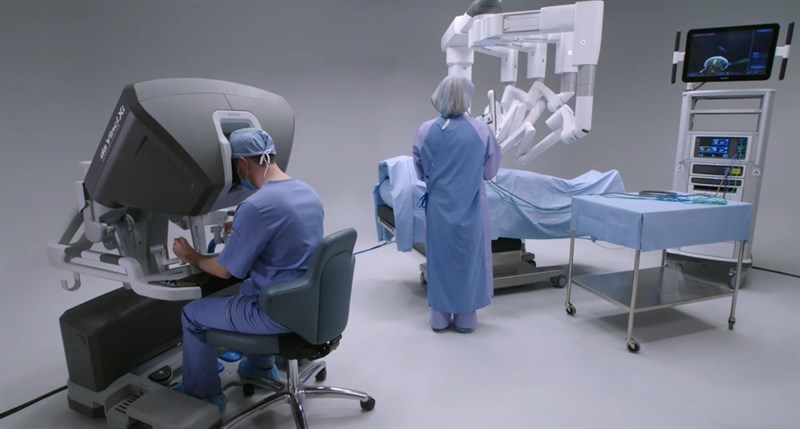What Is Robotic Surgery and How Does It Work?
Jul. 31 2019, Raynetta Stansil, Clinical Educator

Unlike open surgery, minimally invasive surgery allows doctors to operate with less damage to the body, leading to less pain, fewer complications, and an overall shorter hospital stay for patients. For example, laparoscopy, one of the better known forms of minimally invasive surgery, uses one or more small incisions made to the body to pass small tubes, cameras and instruments so doctors can operate without actually opening the body.
Another common type of minimally invasive surgery—and our topic for the day—is robotic surgery, in which doctors can perform many types of complex procedures with more precision, flexibility, and control because they are being assisted by a robotic system that enhances their capabilities and helps them overcome many of the limitations of minimally invasive surgical procedures.
What Is Robotic Surgery?
Robotic surgery is an advanced form of minimally invasive surgery that makes use of computer-controlled robots to do what humans can’t, and what they can do, but better. When you consider how bulky human hands are compared to a robot’s, which can be incrementally thinner while retaining a high degree of dexterity that allows for maneuvering in tight places within the body, you can see why this is. Additionally, when you introduce mechanical elements paired with feedback-controlled motions to surgery, you arrive at actions that are much smoother than anything achieved with a human hand. In effect, this gives surgeons a lot more control to do what they must while also reducing tissue trauma.
How Does Robotic Surgery Work?
While there are a variety of robotic surgery processes, the vast majority will involve a surgeon sitting at a special console with hand and foot controls that allow them to remotely and precisely control surgical instruments attached to robotic arms. Adjustments can also be made to change the scale of the robot’s movement. For example, a three-to-one scale would mean that the tip of the robot’s arm will move one inch for every three inches the surgeon’s hand moves. To see, a small 3D camera is inserted into the patient through a very small incision, which gives them a magnified 360° view of the operative field on a high definition monitor that essentially places them inside the patient. A second surgeon or surgical technician will also be positioned near the patient to confirm the correct placement and function of the surgical instruments.
What Are Common Instruments Used in Robotic Surgery?
More often than not, robotic surgery will be accomplished with the da Vinci Surgical System, which has received FDA clearance for use in a number of surgery types that include:
● Cardiac: Where appropriate, minimally invasive surgery with da Vinci can be used in place of open heart surgery.
● Colorectal: Colon and rectal resection surgery, as well as rectopexy, may be taken care of with da Vinci.
● General surgery: General surgery covers many types of procedures, including inguinal hernia repair that surgeons can perform with da Vinci.
● Gynecology: Doctors may suggest surgery, such as benign hysterectomy, with da Vinci.
● Head and neck: Transoral (through the mouth) robotic-assisted surgery may be an option for mouth and throat surgery.
● Thoracic: When surgery is an option for conditions such as lung cancer, doctors may choose minimally invasive surgery with da Vinci.
● Urology: Doctors may suggest surgery with da Vinci for urology procedures involving the prostate or kidney.
All of these procedures can be accomplished thanks to the three main components that make up the da Vinci system:
1. Surgeon console: Where the surgeon sits to control the instruments while viewing the patient’s anatomy in high-definition 3D. The instruments are “wristed” and move like a human hand, but with a far greater range of motion.
2. Patient cart: Positioned near the patient on the operating table, the patient cart holds the camera and instruments that move in real-time in response to the surgeon’s controls from the console.
3. Vision cart: The vision cart makes communication between components of the system possible and supports the 3D high-definition vision system.
What Are the Advantages of Robotic Surgery?
As you can imagine, there are multiple advantages that stem from utilizing robotics to perform complex surgical procedures. For example, the very fact that the operation is performed through a small incision means that there will be less trauma and pain to the body, as well as minimal scarring, shorter hospitalization, and a faster recovery period. More on the robotic side, using high-definition 3D cameras leads to greater visualization as surgeons gain close-up views of areas they normally would not be able to see in open surgery. Likewise, the use of fully articulating robotic arms that mimic the movement of hands presents surgeons with enhanced dexterity and greater precision than could ever be possible with conventional surgical instruments.
Final Thoughts
The number of surgeons and hospitals choosing to perform surgery with the help of robotic tools has been increasing every year. In fact, it is estimated that the rate of robotic surgeries is increasing by 25% annually. For the most part, robotic surgery is being used by organizations like Surgical Solutions as a form of minimally invasive surgery support to improve operations like laparoscopies by making them both safer and more precise, leading to a better health system as a whole.

Raynetta Stansil, Clinical Educator
Author
RELATED POST
-

Robotic Surgery
Operating Room Insourcing Versus Outsourcing Post COVID-19
Read More



